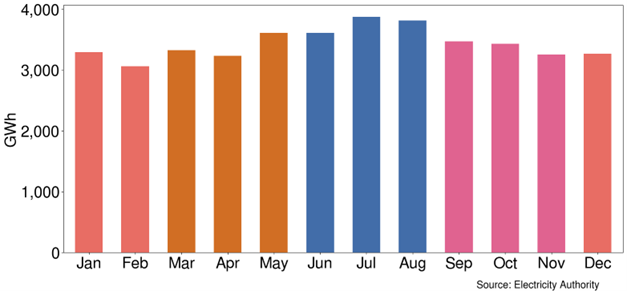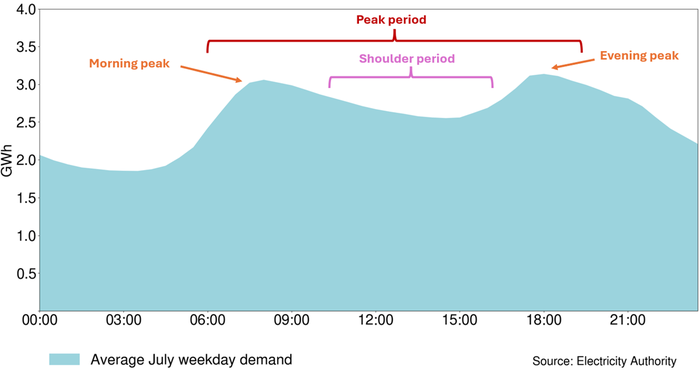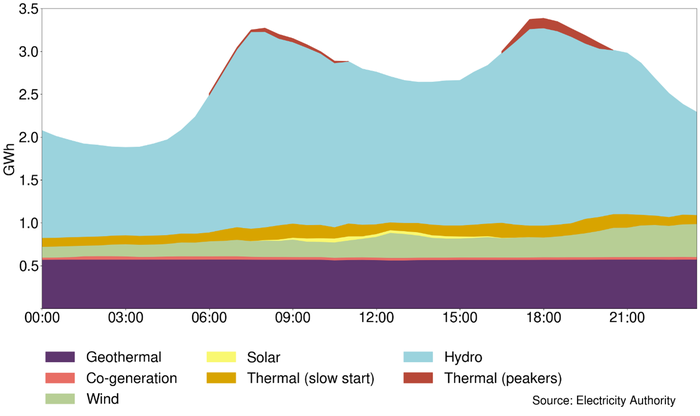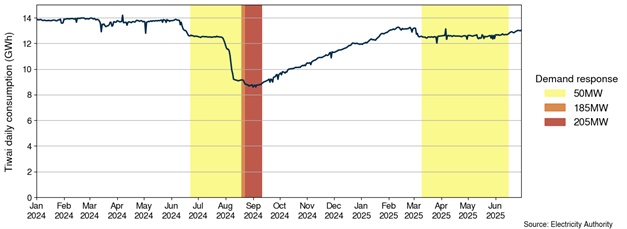Eye on electricity
Demand-side flexibility in a highly renewable power system
- Consumers
- Generation
As New Zealand electrifies, demand for electricity will increase. This increased demand will generally need to be met with new supply. But an important element of meeting this at lowest cost to consumers will be the effective use of demand-side flexibility.
This is where electricity consumers use more electricity during the times when it is cheapest to produce. For a family, this may be delaying dishwasher use until after 9pm. For an industrial electricity user, it may mean ramping down production during morning and evening demand peaks.
Effective demand-side flexibility may reduce overall system costs by preventing the need for unnecessary infrastructure, such as transmission and generation assets, to be built.
This article will explain what drives electricity demand, and the difference between peak, superpeak and offpeak demand. It will also look at how demand impacts the use of renewable and non-renewable electricity and how effective demand management can be achieved by both small and large electricity users in Aotearoa.
Electricity demand has strong daily and seasonal patterns
The majority of electricity demand in New Zealand comes from residential (~36%), industrial (~32%) and commercial (~23%) consumers. Agriculture, forestry and fishing make up about a further 7% combined.
Demand during the winter months is higher than in summer due to increased heating (Figure 1). Rainfall and humidity also affect demand due to dehumidifiers and irrigation for agriculture. Irrigation primarily occurs from September to April and this mostly occurs in Canterbury.
Demand also varies depending on the day. It is higher on business days and lower on the weekend and public holidays. Demand is also often lower during the school holidays.

On a smaller time scale, demand varies throughout the day (Figure 2) with two pronounced peaks. The ‘morning peak’ occurs as people get ready for work or school. The ‘evening peak’ occurs when people are getting home and turning on their appliances and heaters. These two parts of the day are known as the ‘superpeak’.
Between these peaks, demand is lower and this is often referred to as the ‘shoulder’ period. The ‘peak’ period covers the start of the morning peak, the shoulder period, and to the end of the evening peak. Demand is generally lowest at night.
More details about how electricity demand varies over different months, days and times can be found in a previous Eye on Electricity article.

Generation types contribute to meeting demand in different ways
New Zealand has a highly renewable electricity system that uses hydro, geothermal, wind and some solar generation. Last year, just over 85% of all electricity generation was from renewable sources.
The rest is made up of gas, coal and diesel-powered thermal generation, or cogeneration that generates some electricity from industrial processes. Each different type of generation contributes to meeting demand in a different way (Figure 3).
Typically geothermal, hydro and large slow-start thermal generation provide mostly baseload electricity. Wind generation is very variable and depends on our changing weather patterns. Solar generates during daylight hours and mostly between the daily peaks. Hydro has some flexibility to ramp up and meet peak demand, as seen in Figure 3. Thermal generation with capacity and fuel can also ramp up to meet peaks.
The most flexible generation that can quickly ramp up to meet super-peak demand is gas or diesel fired peakers and, increasingly, grid scale batteries. When thermal peakers are needed for short periods to meet demand, they often ‘set’ the spot price for that trading period, which is typically higher than if slow-start thermal or hydro had set the price. Typically, the highest prices of the day occur during the morning and evening peaks.

Demand can be shifted or reduced during high demand periods
Historically, electricity generation was adjusted to match demand. However, in an increasingly renewable power system, where high amounts of renewable—especially solar and wind—generation does not necessarily align with peak demand periods, demand should also be adjusted to meet supply.
Electricity retailers can achieve this by controlling hot water cylinders for their customers. Some retailers have begun offering ‘controlled’ retail plans where the retailer can momentarily switch off hot water cylinders, a large component of household electricity load, usually during peak load times. On a large scale, this will reduce electricity demand and the need for thermal peakers or other expensive generation to dispatch.
Electricity retailers can also achieve demand-shifting by offering their customers lower rates (or even zero cost use) when they use electricity during off-peak or shoulder periods. This encourages their customers to shift their electricity use away from peak load times
Larger industrial consumers can also reduce demand during difficult periods with demand response arrangements. For example, the Tiwai Point aluminum smelter demand response was used over winter 2024 and again in autumn 2025 (Figure 4). More details on the Tiwai demand response can be found in this article. This aids the electricity system on a longer time scale by preserving fuels, water, gas and coal for later use.
All forms of demand-side flexibility are expected to reduce overall system costs, which benefits consumers. If load management is used effectively, the building of generation or transmission assets for peak periods may be able to be delayed. For example, if some electricity use in a peak demand period can be shifted, less thermal peaking generation may be needed over a year.

Encouraging more demand side flexibility
The Electricity Authority Te Mana Hiko is continually working to make things better for New Zealanders. Recently we introduced new rules to make time-of-use pricing plans compulsory for large electricity retailers. This helps to shift demand away from super-peak times and gives consumers more options to reduce their electricity bill by giving them access to cheaper rates for off-peak electricity, and higher rates when they feed electricity back into the system at peak times.
We also recently published a consultation paper that put forward three alternative models for distribution system operators (DSOs). One or more DSOs are needed to coordinate the operation of consumer energy resources (CER) such as rooftop solar, household batteries, electric vehicles and hot water cylinders. The effective orchestration of CERs can contribute significantly to providing demand-side flexibility in the power system.
We’ve also recently consulted on ways to unlock industrial demand flexibility and boost security of New Zealand’s power supply ahead of next winter. The roadmap includes two actions the Authority is proposing, which could be in place by winter 2026:
- Establishing an Emergency Reserve Scheme - this is a peak capacity management tool where industrial demand flexibility could be activated before the system operator instructs involuntary load shedding. Participants in the scheme would be paid for their activity.
- Developing a standardised product for demand flexibility - to facilitate mutual arrangements between retailers and demand flexibility providers, including industrials and aggregators of residential and smaller commercial consumers. This would be developed with industry, as we did successfully for the ‘super-peak’ flexibility product introduced in January 2025, as part of the Energy Competition Task Force work programme.
We are also in the early stages of a project to consider how distributors can increase the visibility of information about their networks (such as available network capacity) to interested parties, including access seekers, flexibility service providers and consumers. We believe that this information supports consumer choice, making the most of available network capacity and identifying locations where distributed energy resources could provide valuable services to interested parties.
Related News
Strong inflows push hydro storage above nominal full
Rainy spring weather and snowmelt have caused national hydro storage in New Zealand to increase beyond ‘nominal full’ capacity - and to its highest level since…
Consultation opens on 2026/27 levy-funded appropriations
We're consulting on our funding plans for the year ahead and welcome your feedback.
Consumer insights helping to shape the Electricity Authority’s work
The Electricity Authority's 2025 Consumer Perceptions and Sentiment Survey shows that affordability remains a pressing concern for New Zealanders and reinforce…